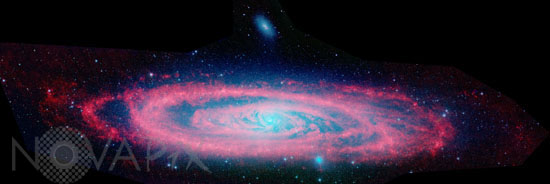Photo Agency - Astronomy - Space - Nature

The Andromeda galaxy seen in infrared
author: Nasa/Jpl/Caltech/Novapix
reference: a-gax02-24072
Image Size 300 DPI: 125 * 41 cm
This infrared composite image from NASA's Spitzer Space Telescope shows the Andromeda galaxy, a neighbor to our Milky Way galaxy. The image highlights the contrast between the galaxy's choppy waves of dust (red) and smooth sea of older stars (blue). Spiral galaxies tend to form new stars in their dusty, clumpy arms, while their cores are populated by older stars.The Spitzer view also shows Andromeda's dust lanes twisting all the way into the center of the galaxy, a region that is crammed full of stars. In visible-light pictures, this central region tends to be dominated by starlight. Astronomers used these new images to measure the total infrared brightness of Andromeda. Because the amount of infrared light given off by stars depends on their masses, the brightness measurements provided a novel method for "weighing" the Andromeda galaxy. According to this method, the mass of the stars in Andromeda is about110 billion times that of the sun, which is in agreement with past calculations. This means the galaxy contains about one trillion stars (because most stars are actually less massive than the sun). For comparison, the Milky Way is estimated to hold about 400 billion stars. The Andromeda galaxy is located 2.5 million light-years away in the constellation Andromeda. It is the closest major galaxy to the Milky Way, making it the ideal specimen for carefully examining the nature of galaxies. On a clear, dark night, the galaxy can be spotted with the naked eye as a fuzzy blob.
Contact : Stéphane Aubin +33-(0)9-51-26-53-76
© Novapix - All rights reserved


